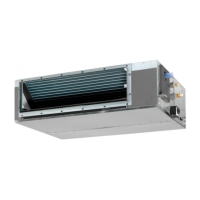port 1
(450×450)
Inspection
port 3
Control box
Control box
800
800
Arrow A-1 Arrow A-2
Inspection port 2
(Indoor unit size
+ 300 or more)
(Indoor unit
size or more)
200mm
or less
D=B+300 or more
B
< In the case of (1)-2, 3 >
Fig. 4
Table 1 (unit [mm])
Model B C D
20·25·32 class 550 588 850
40 class 700 738 1000
50·63·80 class 1000 1038 1300
100·125 class 1400 1438 1700
140 class 1550 1588 1850
(2) Mount canvas ducts to the air outlet and inlet so that
the vibration of the indoor unit will not be transmit-
ted to the ducts or ceiling. Furthermore, attach sound
absorbing material (thermal insulation material) to the
duct inner walls and anti-vibration rubber to the hang-
ing bolts (refer to 8. DUCT WOR
K).
(3) The indoor unit is set to standard external static pres-
sure.
• If external static pressure is higher or lower than the
standard set value, the remote controller may be used to
make on-site setting change in the external static pres-
sure.
Refer to 10. FIELD SETTING.
(4) Open installation holes
(in the case of installation onto the existing ceiling).
• Open the installation holes on the ceiling of the instal-
lati
on location, and work on the refrigerant piping, drain
piping, remote controller wiring (unless a wireless re-
mote controller is used), and wiring between the indoor
and outdoor units to the piping connection port and
wiring connection port of the indoor unit (refer to each
piping and wiring procedure items).
• Ceiling framework reinforcement may be required in
order to keep the ceiling horizontal and prevent ceiling
vibrat
ion after opening the ceiling holes. For details,
consult your building and upholstery work contractors.
(5) Install the hanging bolts.
• Use M8 or M10 bolts for hanging the indoor unit.
Use hole-in-anchors for the existing bolts and embed-
ded inserts or foundation bolts for new bolts, and
the
indoor unit
to the building so that it may withstand
the mass of the unit.
(2) Use hanging bolts for installation.
Investigate if the installation place can withstand the mass
of the indoor unit and, if necessary, hang the indoor unit
with bolts after it is reinforced by beams etc.
4. PREPARATION BEFORE INSTALLATION
(1) Check the relation of location between the ceiling
opening and the indoor unit hanging bolts. (unit [mm])
• Provide one of the following service spaces for the
maintenance and inspection of t
he control box and
drain pump or for other services.
1. Inspection ports 1 and 2 (450 × 450) (Fig. 3-1) and
a minimum space of 300 mm at the bottom of the
product (Fig. 3).
2. Inspection port 1 (450 × 450) on the control box side
and inspection port 2 on the bottom of the product.
(Fig. 4, arrow A-1)
3. Inspection port 3 on the bottom of the product and on
the bottom side of the control box. (Fig. 4, arrow A-2
)
Control box
300 or more
Ceilin Ig nspection port
< In the case of (1)-1 >
Fig. 3
Control box
800
200 or less500
B
C
(Hanging bolt pitch)
Hanging bolts (× 4)
630
Air outlet
Bottom of
indoor unit
* Inspection port 2 is not required
if the bottom space under the product
is accessible for work.
Air inlet
(Hanging bolt pitch)
Inspection port 1
(450×450)
Inspection port 2*
(450×450)
(For drain pan
removal and
component replacement)
Fig. 3-1

